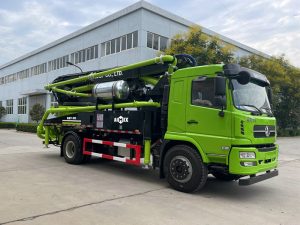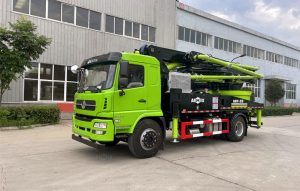Operating a small concrete pump truck effectively over several years demands rigorous maintenance, with tire care being paramount. As these workhorses age, their tires face compounded stresses from weight, vibration, abrasive job sites, and inevitable material degradation. Knowing precisely how to change tires for small concrete pump truck after usage for several years is not just a routine task; it’s a vital safety and operational procedure. Neglecting worn tires on an older unit can lead to catastrophic failure, costly downtime, and significant safety hazards on site. This guide provides a comprehensive, step-by-step approach to executing this critical task safely and efficiently, ensuring your valuable equipment remains reliable and roadworthy despite the years of demanding service it has endured.

Understanding the Imperative for Timely Replacement on Older Trucks
The tires on a small concrete pump truck bear extraordinary loads – the truck chassis itself, the weight of the concrete pump and associated machinery, the liquid concrete within the system during operation, and often additional tools or materials. After several years of service, several factors converge to make tire replacement not just advisable but essential. Rubber compounds naturally harden and lose elasticity over time, even with minimal tread wear, significantly reducing grip and increasing susceptibility to cracking and blowouts, especially under the high-stress conditions of pumping operations. The internal structure, including belts and cords, fatigues from constant flexing under heavy loads and the unique vibrations generated by the concrete pump, which can be particularly harsh on an aging chassis with potentially worn mounts. Tread depth inevitably diminishes, but on older tires, uneven wear patterns become more pronounced, potentially indicating alignment issues, suspension problems specific to the pump truck’s configuration, or improper inflation maintained over years. Sidewalls develop weather-checking (small cracks) which deepen with age and exposure, weakening the tire’s integrity. Furthermore, tires on equipment like concrete pumps for sale often endure prolonged periods of static weight when the truck is parked on site between pours, leading to flat-spotting that may not fully recover on older, stiffer rubber. Recognizing these age-related wear factors, distinct from simple mileage wear, is crucial for preemptive replacement before failure occurs.
Essential Preparations: Safety and Tools First
Before approaching the tire, meticulous preparation is non-negotiable, especially given the age and potential corrosion of components. First, ensure the small concrete pump truck is parked on a firm, level, stable surface, far from traffic and hazards; engage the parking brake firmly and chock the wheels diagonally opposite the tire you intend to change with substantial blocks – never rely solely on the parking brake, particularly on an older vehicle where brake components may have wear. Consult the truck’s specific operator manual for the designated jacking points; these are critical as jacking in the wrong location on a heavy pump truck can damage the frame or chassis rails and cause instability. Gather all necessary tools: a heavy-duty hydraulic bottle jack or service jack rated significantly *higher* than the truck’s axle weight (check manual specifications), robust jack stands rated for the same capacity (NEVER work under a vehicle supported only by a jack), a lug wrench or properly sized impact wrench with deep sockets, a torque wrench (absolutely essential for final tightening), wheel wedges or additional chocks, a wire brush, penetrating oil (like PB Blaster or similar, crucial for likely corroded lug nuts), a tire pressure gauge, and personal protective equipment (PPE) including heavy-duty gloves, safety glasses, and steel-toed boots. If changing a dual tire, ensure you have appropriate tools for handling the inner wheel. For sourcing replacements, researching reputable dealers offering concrete pumps for sale can often lead you to suppliers knowledgeable about the specific tire requirements and load ratings needed for your aging pump truck model.
The Step-by-Step Tire Changing Procedure
Once fully prepared, begin by loosening, but not removing, the lug nuts on the wheel while the truck is still firmly on the ground; the weight of the vehicle prevents the wheel from spinning. Apply penetrating oil liberally to each lug nut and stud, especially on an older truck where corrosion is highly probable – allow it to soak in for several minutes or longer if severely stuck. Position the heavy-duty jack precisely under the manufacturer’s specified jacking point nearest the tire being changed. Raise the jack slowly and steadily only until the tire clears the ground by about one to two inches; excessive height increases instability. Immediately place the appropriately rated jack stands under a secure, structural point of the axle or frame (as per the manual) and lower the jack slightly until the truck’s weight rests securely on the stands. Perform a stability check by gently rocking the truck – it must not move on the stands. Now, completely remove the loosened lug nuts. If dealing with dual tires, remove the outer wheel first, then the inner. Older wheels, particularly steel ones common on work trucks, may be rusted or seized onto the hub. If the wheel won’t budge after lug nut removal, carefully tap around the rim’s edge (not the tire sidewall) with a rubber mallet or a block of wood and hammer from behind, alternating sides. Avoid excessive force which could damage studs or the hub. Once free, carefully pull the wheel assembly straight off the hub, controlling its considerable weight. Mount the new, correctly specified tire and wheel assembly onto the hub studs, ensuring it sits flush. Hand-tighten all lug nuts in a star pattern to center the wheel properly. Carefully raise the jack slightly to take the weight off the stands, remove the stands, and then slowly lower the truck completely to the ground.
Final Tightening, Inspection, and Post-Change Protocol
With the truck fully grounded, proceed to tighten the lug nuts in the proper star or criss-cross pattern using the lug wrench or impact wrench. This sequence ensures even pressure distribution and prevents warping the wheel, critical for both safety and preventing vibration. Crucially, you must now use the torque wrench to tighten the lug nuts to the exact manufacturer’s specification for your small concrete pump truck model; this information is found in the operator’s manual or sometimes on a decal near the door jamb or wheel well. Overtightening can stretch or break studs, especially older, potentially fatigued ones, while undertightening risks the wheel coming loose. Torque the nuts in stages, following the star pattern, and recheck the final torque setting twice. Once torqued, remove the chocks. Check the air pressure in the new tire immediately, inflating it to the recommended PSI stated on the tire placard (usually found on the driver’s door jamb or fuel filler door) – do not rely on the pressure set at the shop, as it may have changed. Conduct a thorough visual inspection: ensure no tools are left behind, the tire clears all components (especially important on dual axles or near pump outriggers), and the valve stem cap is securely replaced. For dual tires, ensure adequate clearance between them. Finally, before moving the truck, gently roll it forward and backward a short distance, then recheck the lug nut torque once more after this initial settling. Document the tire change in your maintenance log, noting the date, mileage/hours, tire brand/size, and position installed.
Changing tires on a small concrete pump truck that has served diligently for years requires heightened attention to safety, potential corrosion, and precise procedures. Following this meticulous process mitigates risks associated with aged components and ensures your vital equipment remains safe and operational. Proactive tire maintenance, including timely replacement based on age and condition, is a wise investment in the longevity and reliability of your pump truck, maximizing its value whether you’re actively using it or considering concrete pumps for sale in the future. Never underestimate the critical role properly maintained tires play in the overall safety and performance of your aging workhorse.

Leave a Reply